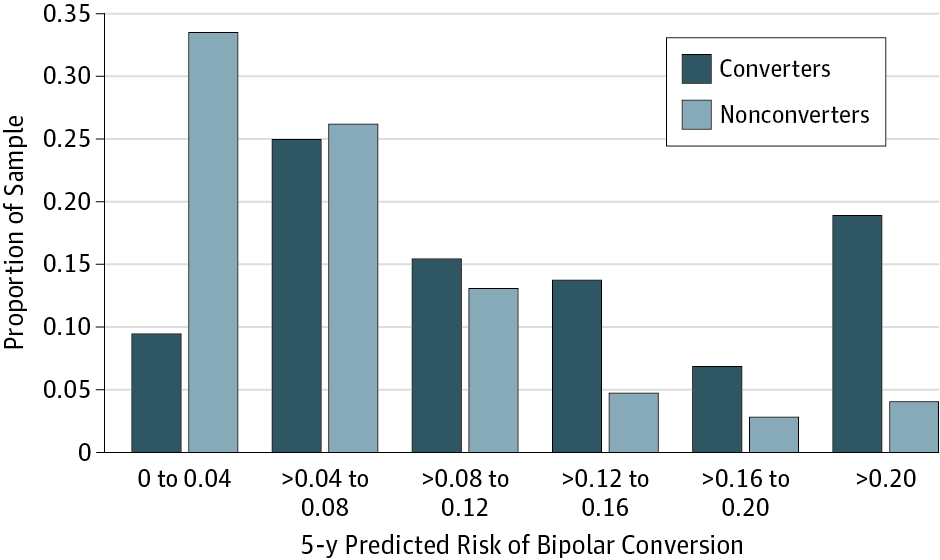当前位置:
X-MOL 学术
›
JAMA Psychiatry
›
论文详情
Our official English website, www.x-mol.net, welcomes your feedback! (Note: you will need to create a separate account there.)
Assessment of a Person-Level Risk Calculator to Predict New-Onset Bipolar Spectrum Disorder in Youth at Familial Risk.
JAMA Psychiatry ( IF 25.8 ) Pub Date : 2017-08-01 , DOI: 10.1001/jamapsychiatry.2017.1763 Danella M Hafeman 1 , John Merranko 1 , Tina R Goldstein 1 , David Axelson 2 , Benjamin I Goldstein 3 , Kelly Monk 1 , Mary Beth Hickey 1 , Dara Sakolsky 1 , Rasim Diler 1 , Satish Iyengar 4 , David A Brent 1 , David J Kupfer 1 , Michael W Kattan 5 , Boris Birmaher 1
JAMA Psychiatry ( IF 25.8 ) Pub Date : 2017-08-01 , DOI: 10.1001/jamapsychiatry.2017.1763 Danella M Hafeman 1 , John Merranko 1 , Tina R Goldstein 1 , David Axelson 2 , Benjamin I Goldstein 3 , Kelly Monk 1 , Mary Beth Hickey 1 , Dara Sakolsky 1 , Rasim Diler 1 , Satish Iyengar 4 , David A Brent 1 , David J Kupfer 1 , Michael W Kattan 5 , Boris Birmaher 1
Affiliation

|
Importance
Early identification of individuals at high risk for the onset of bipolar spectrum disorder (BPSD) is key from both a clinical and research perspective. While previous work has identified the presence of a bipolar prodrome, the predictive implications for the individual have not been assessed, to date.
Objective
To build a risk calculator to predict the 5-year onset of BPSD in youth at familial risk for BPSD.
Design, Setting, and Participants
The Pittsburgh Bipolar Offspring Study is an ongoing community-based longitudinal cohort investigation of offspring of parents with bipolar I or II (and community controls), recruited between November 2001 and July 2007, with a median follow-up period of more than 9 years. Recruitment has ended, but follow-up is ongoing. The present analysis included offspring of parents with bipolar I or II (aged 6-17 years) who had not yet developed BPSD at baseline.
Main Outcomes and Measures
This study tested the degree to which a time-to-event model, including measures of mood and anxiety, general psychosocial functioning, age at mood disorder onset in the bipolar parent, and age at each visit, predicted new-onset BPSD. To fully use longitudinal data, the study assessed each visit separately, clustering within individuals. Discrimination was measured using the time-dependent area under the curve (AUC), predicting 5-year risk; internal validation was performed using 1000 bootstrapped resamples. Calibration was assessed by comparing observed vs predicted probability of new-onset BPSD.
Results
There were 412 at-risk offspring (202 [49.0%] female), with a mean (SD) visit age of 12.0 (3.5) years and a mean (SD) age at new-onset BPSD of 14.2 (4.5) years. Among them, 54 (13.1%) developed BPSD during follow-up (18 with BD I or II); these participants contributed a total of 1058 visits, 67 (6.3%) of which preceded new-onset BPSD within the next 5 years. Using internal validation to account for overfitting, the model provided good discrimination between converting vs nonconverting visits (AUC, 0.76; bootstrapped 95% CI, 0.71-0.82). Important univariate predictors of outcome (AUC range, 0.66-0.70) were dimensional measures of mania, depression, anxiety, and mood lability; psychosocial functioning; and parental age at mood disorder.
Conclusions and Relevance
This risk calculator provides a practical tool for assessing the probability that a youth at familial risk for BPSD will develop new-onset BPSD within the next 5 years. Such a tool may be used by clinicians to inform frequency of monitoring and treatment options and for research studies to better identify potential participants at ultra high risk of conversion.
中文翻译:

评估个人风险计算器以预测有家庭风险的青年新发双相情感障碍。
重要性 从临床和研究的角度来看,早期识别双相谱系障碍 (BPSD) 高危人群是关键。虽然以前的工作已经确定了双相前驱症状的存在,但迄今为止尚未评估对个体的预测影响。目的 建立一个风险计算器来预测具有 BPSD 家族风险的青年 BPSD 的 5 年发病率。设计、设置和参与者 匹兹堡双相后代研究是一项持续的社区纵向队列调查,对象为双相 I 或 II(以及社区对照)父母的后代,招募时间为 2001 年 11 月至 2007 年 7 月,中位随访期超过9年。招聘已经结束,但后续工作正在进行中。目前的分析包括双相 I 或 II(6-17 岁)的父母在基线时尚未发生 BPSD 的后代。主要结果和测量 本研究测试了事件发生时间模型预测新发病的程度,包括情绪和焦虑测量、一般心理社会功能、双相父母情绪障碍发病年龄和每次就诊年龄BPSD。为了充分利用纵向数据,该研究分别评估了每次访问,并在个体内进行聚类。歧视是使用曲线下面积(AUC)来衡量的,预测5年风险;使用 1000 个自举重采样进行内部验证。通过比较观察到的与预测的新发 BPSD 的概率来评估校准。结果有412名有风险的后代(202名[49.0%]女性),平均 (SD) 就诊年龄为 12.0 (3.5) 岁,新发 BPSD 的平均 (SD) 年龄为 14.2 (4.5) 岁。其中,54例(13.1%)在随访期间出现BPSD(18例伴BDⅠ或Ⅱ);这些参与者总共进行了 1058 次就诊,其中 67 次(6.3%)在未来 5 年内出现新发 BPSD。使用内部验证来解释过度拟合,该模型提供了转换访问与非转换访问之间的良好区分(AUC,0.76;自举 95% CI,0.71-0.82)。结果的重要单变量预测因子(AUC 范围,0.66-0.70)是躁狂、抑郁、焦虑和情绪不稳定性的维度测量;心理社会功能;和情绪障碍的父母年龄。结论和相关性 该风险计算器提供了一个实用工具,用于评估具有 BPSD 家族风险的青年在未来 5 年内发展为新发 BPSD 的可能性。临床医生可以使用这种工具来告知监测和治疗选择的频率,并用于研究以更好地识别具有超高转换风险的潜在参与者。
更新日期:2017-08-11
中文翻译:

评估个人风险计算器以预测有家庭风险的青年新发双相情感障碍。
重要性 从临床和研究的角度来看,早期识别双相谱系障碍 (BPSD) 高危人群是关键。虽然以前的工作已经确定了双相前驱症状的存在,但迄今为止尚未评估对个体的预测影响。目的 建立一个风险计算器来预测具有 BPSD 家族风险的青年 BPSD 的 5 年发病率。设计、设置和参与者 匹兹堡双相后代研究是一项持续的社区纵向队列调查,对象为双相 I 或 II(以及社区对照)父母的后代,招募时间为 2001 年 11 月至 2007 年 7 月,中位随访期超过9年。招聘已经结束,但后续工作正在进行中。目前的分析包括双相 I 或 II(6-17 岁)的父母在基线时尚未发生 BPSD 的后代。主要结果和测量 本研究测试了事件发生时间模型预测新发病的程度,包括情绪和焦虑测量、一般心理社会功能、双相父母情绪障碍发病年龄和每次就诊年龄BPSD。为了充分利用纵向数据,该研究分别评估了每次访问,并在个体内进行聚类。歧视是使用曲线下面积(AUC)来衡量的,预测5年风险;使用 1000 个自举重采样进行内部验证。通过比较观察到的与预测的新发 BPSD 的概率来评估校准。结果有412名有风险的后代(202名[49.0%]女性),平均 (SD) 就诊年龄为 12.0 (3.5) 岁,新发 BPSD 的平均 (SD) 年龄为 14.2 (4.5) 岁。其中,54例(13.1%)在随访期间出现BPSD(18例伴BDⅠ或Ⅱ);这些参与者总共进行了 1058 次就诊,其中 67 次(6.3%)在未来 5 年内出现新发 BPSD。使用内部验证来解释过度拟合,该模型提供了转换访问与非转换访问之间的良好区分(AUC,0.76;自举 95% CI,0.71-0.82)。结果的重要单变量预测因子(AUC 范围,0.66-0.70)是躁狂、抑郁、焦虑和情绪不稳定性的维度测量;心理社会功能;和情绪障碍的父母年龄。结论和相关性 该风险计算器提供了一个实用工具,用于评估具有 BPSD 家族风险的青年在未来 5 年内发展为新发 BPSD 的可能性。临床医生可以使用这种工具来告知监测和治疗选择的频率,并用于研究以更好地识别具有超高转换风险的潜在参与者。



























 京公网安备 11010802027423号
京公网安备 11010802027423号